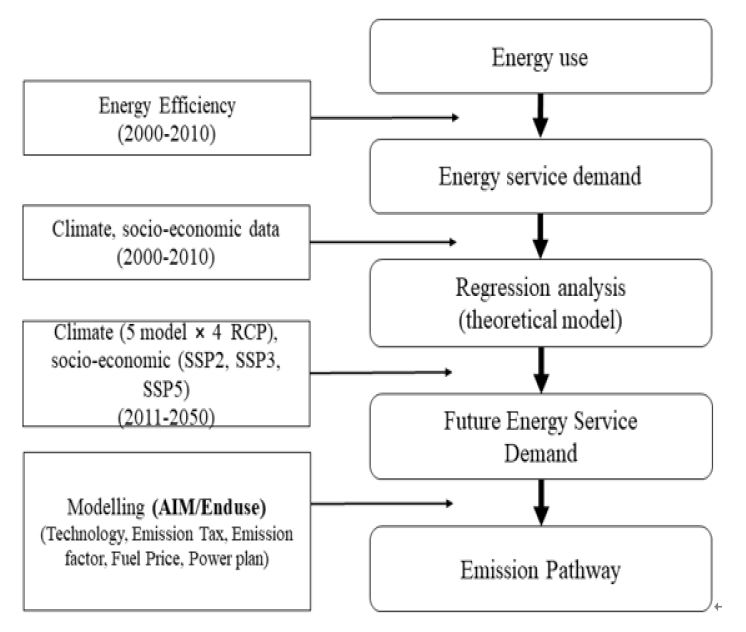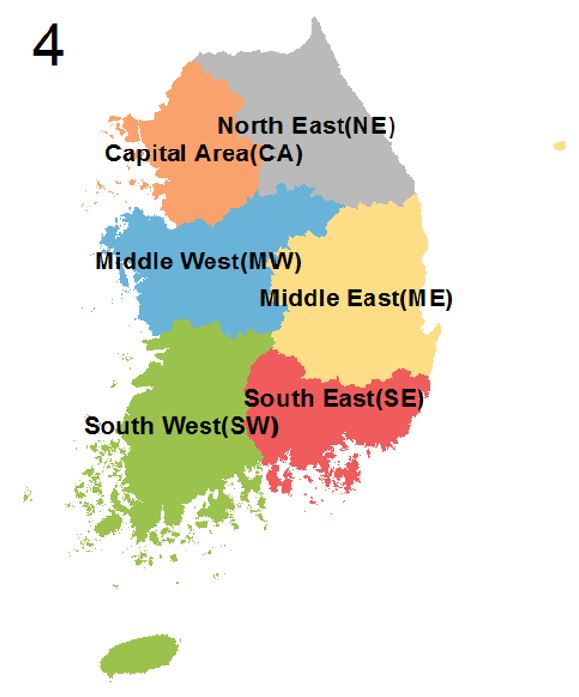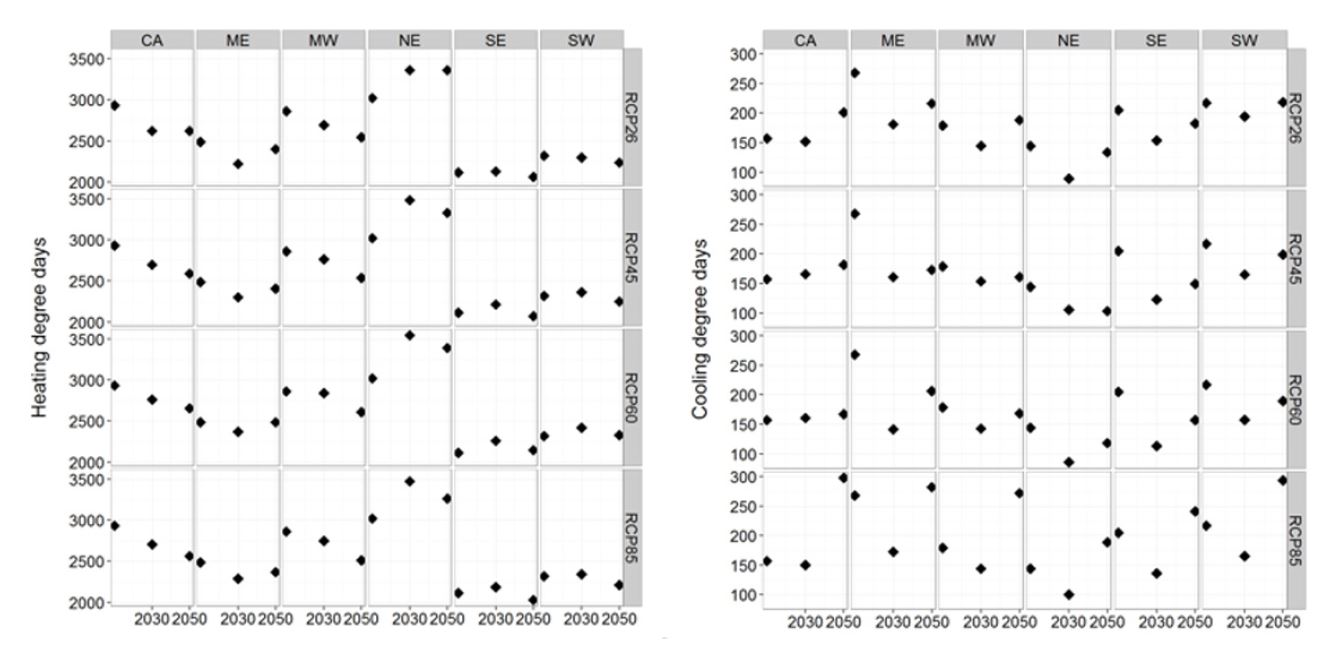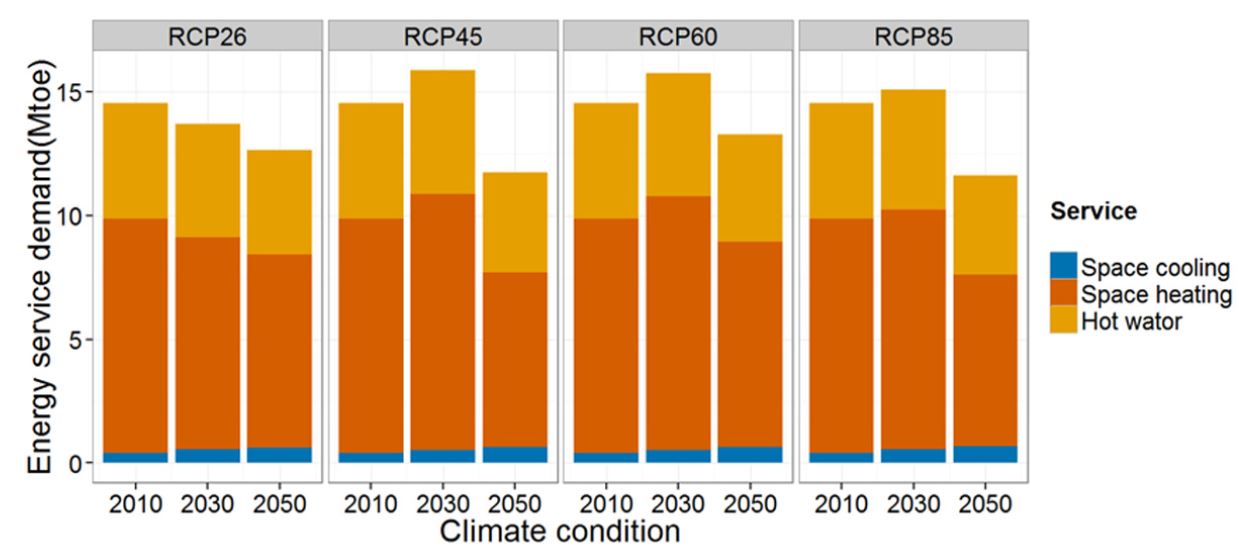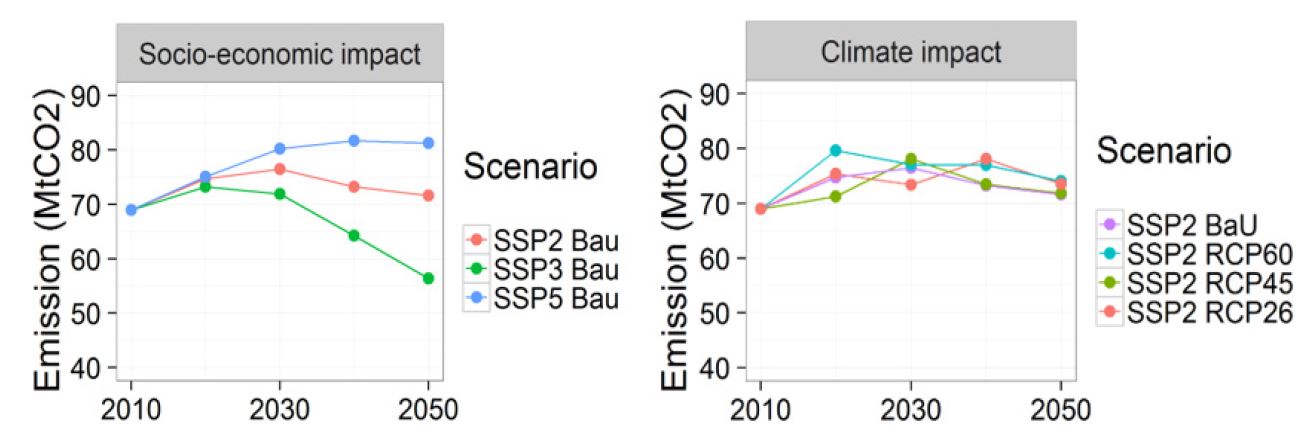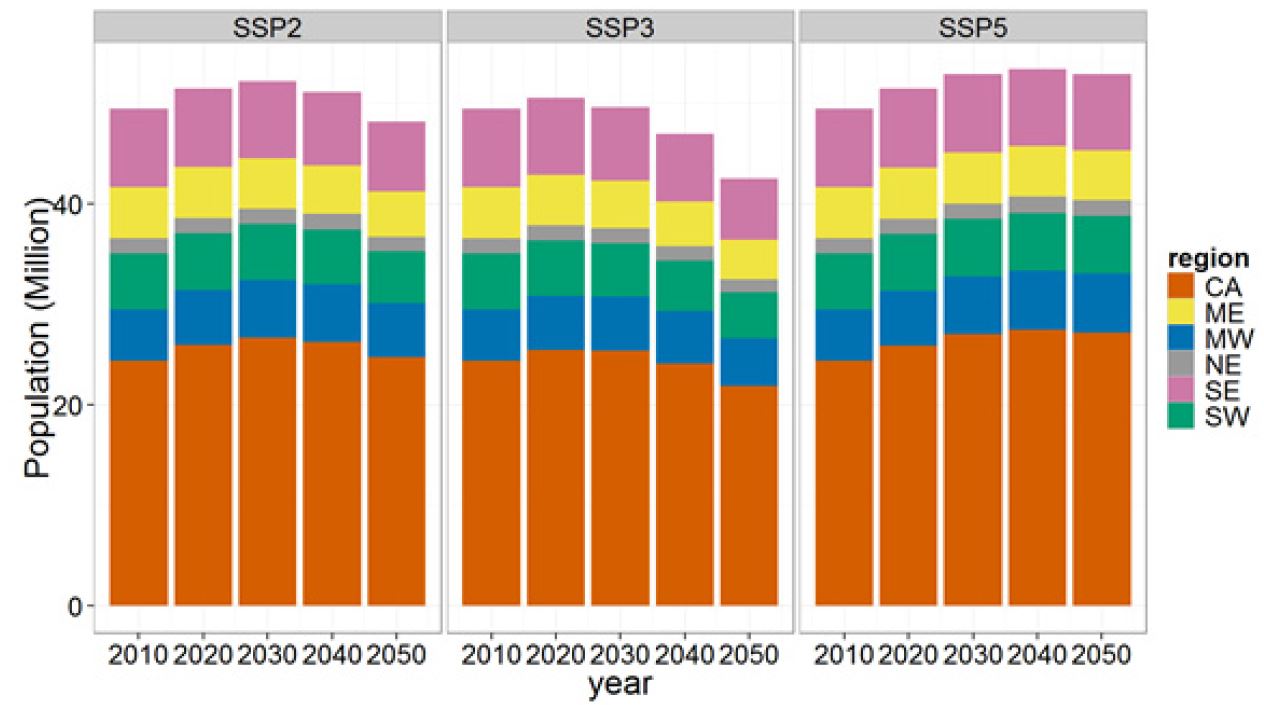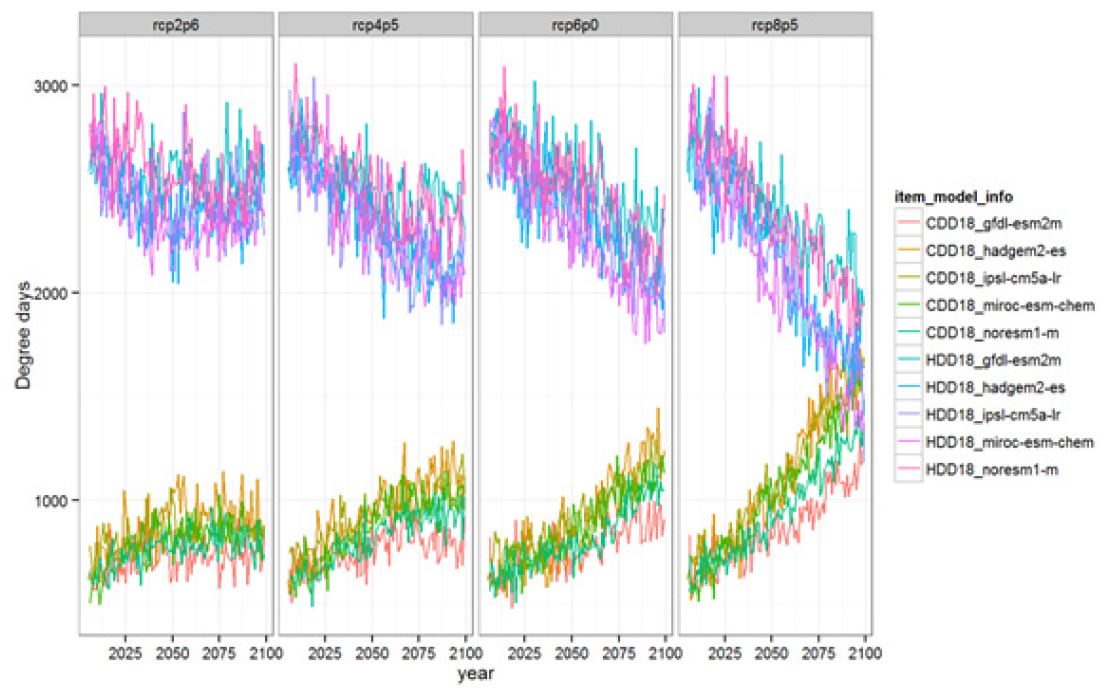
Impacts of Climate Change, Income Change, and Mitigation Measures on CO2 Emission in the Korean Residential Sector in 2050
Abstract
This study analyzes potential CO2 emission pathways in the Korean residential sector by using the bottom-up optimization model, AIM/Enduse. This study focuses on: 1) estimating potential emissions considering future changes in population, GDP, and temperature, 2) assessing the mitigation potential of CO2 with a mitigation measures including carbon tax. 3) discussing co-benefits of air pollutants mitigation such as NOx, SO2 in the context of climate mitigation measures in the Korean residential sector. As a result, population and GDP variation shows an overwhelming impact on CO2 emission. Climate change may help to reduce energy consumption and CO2 emission in Korea due to heating and hot-water use demand decreasing. The carbon tax of 20, 50, 100, 200, 300, 500, 1000 US$/tCO2 in 2050 can reduce 1.0%, 2.5%, 3.6%, 9.6%, 12.2%, 14.1%, and 19.7% of CO2 emission respectively compared to BaU scenario of SSP2 with current technology selection behavior based on life cycle cost. There is also a benefit of large reduction potential of air pollutants, in the range of 5-40% reductions in with CO2 mitigation measures.
Keywords:
AIM/Enduse, Bottom-up approach, Socio-economic scenario, RCP scenario, co-benefit1. Introduction
Human welfare and climate change are both increasingly critical drivers affecting policies, regulations and investment in the energy sector. Our society faces severe and possibly permanent alterations due to climate change. Ambitious long-term climate targets are being seriously considered to avoid the worst case of climate impacts (Ciscar and Dowling, 2014). Before setting the climate targets, policy makers and managers must carefully assess the potential barriers, costs, benefits, and unintended social and environmental consequences, considering the overall possible changes in the future. One way is to understand future energy service demand in more detail, and the possible reduction of CO2 emission and its co-benefits of air-pollutant emission. If health benefits, climate change, and other environmental benefits were quantified, society would be able to reduce unintended investment risks.
Worldwide, households consume about a third of all end-use energy. In countries in a temperate climate zone, more than half of this energy is typically used for heating (IEA, 2004). Korea also emit 13.5% of CO2 in residential sector in 2007 and uses more than 60% of household energy for heating and hot-water (Yoon et al., 2010). Rising incomes and the human welfare movement in Korea could lead perhaps to an increase in demand for household energy services. Global climate change trends also are causing energy use patterns in the household sector to change. In addition, there are equally important questions about how the residential sector be affected by climate policies.
On the global scale, the integrated model (ENVISAGE, ICES, GRACE, AIM/CGE, IMAGE and IGEM) is used to predict impact of socio-economic change on emissions. These model’s results are not fully integrated with energy demand, climate change, and mitigation measures. On the regional scale, some studies have been performed for the USA (Rong et al 2007; Zhou et al 2013), India (Chaturvedi et al 2014), and China (Yu et al 2014; Zhou et al 2013). Nevertheless, of these regional and global study, there is still a lack of studies that can be accessing integrated impacts of population change, life style change, climate change, and climate policies on CO2 reduction potential, and benefits.
Residential sector is key area to observe to check overall possible changes in the future for decision making. In this paper, we attempt to describe changes in CO2 emissions induced by the Korean residential sector. We fully integrate socio-economic change, climate change, and the effect of mitigation measures in the context of shared socio-economic pathway (SSP), and future climate conditions with representative concentration pathways (RCP) trajectories. The primary objective is to develop a detailed analysis of energy service demand based on climate change and socio-economic changes such as population and income with 6 mega-region analysis. The study then discusses for the sake of clarity CO2 emission reduction and the co-benefit of air pollutants reduction potentials as a result of climate policies.
2. Methodology
2.1 Modeling framework
This analysis consists of two parts: 1) estimating potential emissions considering future changes in population, income and climate, 2) assessing the mitigation potential of CO2 with a carbon tax scenario and analyzing co-benefits of reducing air pollutants such as NOx, SO2, and so on by using a technology bottom-up model, the AIM/Enduse model (Fig. 1). We develop regression model of energy service demand using energy use data, technology efficiency, and climate data from 2000 and 2010. We predict future energy service demand with 3 SSPs and 4 RCP scenarios using empirical model. We set the scenario to answer our research question and analyze our scenario using AIM/Enduse model. This scenario framework is envisioned as being useful to address a variety of questions, such as investigating in more detail its dependence on both the level of climate change and future socioeconomic conditions, evaluation of specific policies, and discovering the tradeoffs and synergies of reducing air-pollutant reduction while reducing CO2s under mitigation measures.
2.2 AIM/Enduse
The AIM/Enduse model is a bottom-up optimization model with a detailed mitigation technology selection method. The model firstly analyzes combinations of technologies in order to satisfy the future service demand in each service and sector, then estimates CO2 emissions and final energy consumption in the demand sectors and uses the given final energy demand to estimate the CO2 emissions and primary energy consumption for the power generation sector. Technologies are selected in a linear optimization framework to minimize the total system costs including initial costs, the operating costs of technologies, energy costs, taxes and subsidies, and other costs. The AIM/Enduse model is a recursive dynamic model which can simultaneously perform calculations for multiple years and can analyze various CO2 emission scenarios under several constraints such as satisfaction of service demands, availability of energy and material supplies, and other system constraints (Kainuma et al, 2003; Hanaoka et al, 2015).
2.3 Scope and target
The Korea residential model was developed with 6 mega-regions to predict future impact more precisely as a model with finer resolution can provide more insights in the national level estimation. We referred to economic dependency and cultural similarity to disaggregate Korea. The mega-regions were the Capital Area (CA), the Middle West area (MW), the South West area (SW), the North East area (NE), the Middle East area (ME), and the South East area (SE). This study simulates from 2010 to 2050 to gain mid-long-term information on CO2 emissions.
2.4 Energy service demand
The residential sector was divided by heating, hot-water, cooling, cooking, lighting, refrigeration, Information and Communication Technology (ICT), and other services as shown in Table 1.
We used a decomposition analysis method to predict future energy service demand (Isaac and van Vuuren, 2009). Energy service demand is divided by activity and intensity. Activity is the population in this study, and intensity is energy service demand per person. For intensity change modeling, a general liner regression method was developed using variables (GDP, heating degree days (HDD), cooling degree days (CDD), and so on). To make each service regression model, four-year regional panel data sets (2001, 2004, 2007, and 2010) were used (Eq. 1 and 2). The Gomertz curve function is used to estimate device penetration. The regression method was applied to identify the intensity change due to socio-economic changes and lifestyle changes, using energy service demand. All SSP scenario and all climate condition (RCP scenario) data was used mainly to illustrate possible feedback between climate change and energy service demand.
Current energy service demand
| (Eq. 1) |
| (Eq. 2) |
Future energy service demand
| (Eq. 3) |
| (Eq. 4) |
Where, RSD: Energy Service Demand, EC: Energy Consumption, EE: Energy Efficiency, DP: device penetration (r: Region, s: Service, e: Energy, d: Device)
2.5 Disaggregation of population and GDP
In order to prepare the local scale drivers such as population and GDP, ideally a local model will be developed, and parameters will be calculated to replicate a national value that is equal to the total of local values. But even though a local model similar to the national model can be used, it is difficult to replicate the national values and provide a theoretical basis to change the parameters. Based on the calculated regional population change, the annual regional population is calculated. The national GDP per capita up to 2050 is calculated from SSPs, and the regional GDP per capita in the benchmark year is also calculated. The regional GDP is adjusted to meet the national total value using the regression and convergence year that correspond with SSP storylines (van Vuuren et al., 2012). Disaggregation of population and GDP into mega-regions using SSP scenario results has been described (See appendix).
2.6 Heating degree days (HDD) and Cooling degree days (CDD)
HDDs and CDDs can have an important influence on heating and cooling demand. Degree-days are the summation of temperature differences from a human comfort level over time. They capture both extremity and duration of difference between outdoor temperatures and reference temperatures. Heating degree days are degree-days below the ‘‘set point’’ of 18°C, and cooling degree days are degree-days above the ‘‘set point’’ of 24°C The population grid in 2005 was used for the weighting to provide a more precise explanation at provincial level. To remove model uncertainty, an average of five major climate models (gfdl-esm2m, hadgem2-es, ipsl-cm5a-lr, miroc-esm-chem, noresm1-m) and four RCPs (RCP2.6, RCP4.5, RCP6.0, RCP8.5) for each model are used to derive future climate (See appendix).
3. data and scenario
3.1 Population and GDP
In order to estimate future service demand, it is important to set socio-economic drivers such as population growth rate and GDP growth rate. This study used the population growth and GDP growth ratio (instead of income) based on the SSP scenario developed by Statistics Korea, Korea Development Institute, IIASA and OECD. In this research, SSP2 (similar with medium-growth scenario from Korea government projection), SSP3, and SSP5 were selected. SSP2 show similar pattern and range with SSP1 and SSP4 in Korea.
According to the SSP2 scenario and the government forecast, the total population for Korea is projected to decrease from 49.4 million people in 2010 to 48.8 million people in 2050. The annual rate of population growth is expected to decrease from 0.46 percent in 2010 to 0.28 percent in 2020. Beginning in 2031, the population growth rate will become negative, then decline to -1.0 percent in 2050. The population of most areas, except the CA and MW areas, are expected to decrease from 0.88 to 0.98 compared to that of the 2010 level. The number of households is expected to increase because of the increasing total population in the CA and MW regions, and family size will decrease from around three to two. The Gross Domestic Product (GDP) in SSP2, SSP3, and SSP5 will expand respectively, 3.2, 2.7, and 2.8 percent from 2010 to 2030, 2.0, 0.3, and 2.6 percent from 2031 to 2050 according to OECD outlook. The proportion of GDP is 49% (CA), 12% (MW), 11% (SW), 2% (NE), 9% (ME), and 16% (SE) in 2010.
3.2 Climate change
HDD and CDD correspond to the long-term global average temperature. HDD is expected to decrease among RCP scenarios and regions except for the NE region (Fig 4). CDD trends vary over time, associated with variability in RCP scenarios and regions (Fig 4). It might be expected that predicting cooling energy service demand is relatively important. The RCP85 scenario shows high CDD changes in all regions.

Population and GDP per capita with different SSP scenarios from IIASA database and the Korean government prediction (KOR) from Statistics Korea (Population) and Korea Development Institute (GDP).
3.3 Scenario
Assumptions of socio-economic factors and service demands were the same across the scenarios and only technology selections were different as they were determined by the AIM/Enduse model to satisfy these given service demands. Estimations of mitigation potentials are influenced by the portfolio of various mitigation measures, and various options are available for accelerating the introduction of energy efficient technologies on the demand side.
In this study, there is a scenario setting for estimating the impacts of socio-economic change, climate change, and mitigation measures on CO2, as shown in Table 2. Each SSP scenario (SSP2, SSP3, SSP5) under the climate conditions of the RCP85 scenario were used with the same policy and same discount rate to analyze socio-economic change impacts. For the climate impact, the SSP2 scenario under the four RCP cases is used with the same conditions and socio-economic change impact. We looked at three scenarios, one with technology frozen, one with BaU with no tax, and one economic scenario with tax from 50 ~ 1000 $/tCO2 in 2050. Decisions require considering comprehensive strategies of pay-back time, and here the model uses a low discount rate, 5%, equivalent to the current interest of Korea, and a high discount rate of about 10% to 33% which is related Japan’s device life cycle study.
3.4 Technology database, energy database, emission factors and energy resources
Understanding current patterns of energy consumption in Korea is important because they determine the potential for energy share and allow the model to represent the preferences for individual energy services. Energy balances (KEEI, 2011) give the total residential sector energy consumption for Korea. We used technology efficiency and ownership ratio to calculate energy service demand (Korea Power Exchange, 2011). The AIM/Enduse model require an energy database, an energy resource database and a technology option database. In the energy database, information on emission factors and energy prices are stored. In this study, we developed AIM/Enduse Korea database using current energy, technology data. Energy prices are set exogenously, and they are one of the important factors in estimating mitigation costs. Current energy prices were set based on current price and taxes and future international energy prices in the midterm were set based on IEA World Energy Outlook (IEA, 2010). The future energy prices by fuel type, sector, and country were set under the assumption that domestic energy prices would rise with international energy prices. Emission coefficients are important factors for estimating emissions amounts. Regarding air pollutants, this study considered emission coefficients of primary emissions derived from energy combustion, and they were set by energy source, based on various international emissions factor guidelines and Korean reports (NIER, 2013). This study used the 7th Korean government power generation plan to observe the possibility of reductions as this plan combines both energy security issues and social concerns.
4. Results and discussion
4.1 Empirical model
The regression model results of each services are given in Table 4. Heating service demand and hot-water service demand per person will be influenced by HDD changes. This model can account for 65% and 55% of each. Cooling demand not only depended on CDD but also on purchasing of air-conditioning systems, which is usually described as an S-shaped curve function of the level of income. Lighting service demand per person was affected by income. Cooking depended on an income level at which people go outside of the home to eat. Other appliances such as refrigerators, TVs, computers, and so on were also correlated with income level
Figs 5. and 6. show energy service demand among the three SSP scenario under the RCP85 scenario. According to our model, final energy service demand does not grow significantly across the scenario up to 2050, which is predominantly due to the declining population. Energy service demand in the residential sector increases to 1.08 ~ 1.15 times among SSP scenario between 2010 and 2050 and changes to 0.86 ~ 1.23 times between 2010 and 2050. Socio-economic variation shows an overwhelming impact on CO2 emissions when we think about a sufficient energy supply. Energy service demand is sensitive to climate, growth of population and GDP, and region in terms of magnitude and spatial pattern. Although the model does not include macroeconomic impacts beyond energy service demand, there is evidence that accounting for feedback effects both the economy and energy service demand. The relative impact of these factors varies across space and time. For example, in the SW and SE region, climate change has an impact comparable to population growth, while in other province, such as the CA region, population growth shows an overwhelming impact. When cross-province population movements occur on a more active basis, by adaptation to temperature, energy service demand for heating and hot-water can be reduced more in the future. These results are consistent with all regions in Korea. Other services using electricity are expected to increase their service demand because of population increase and higher income levels. Demand for power for cooking is decreasing due to lifestyle change. People want to go outside to eat when they earn more money. Household expenditure for eating outside of the home is strongly correlated with GDP increases (Lee and Kim, 2005).
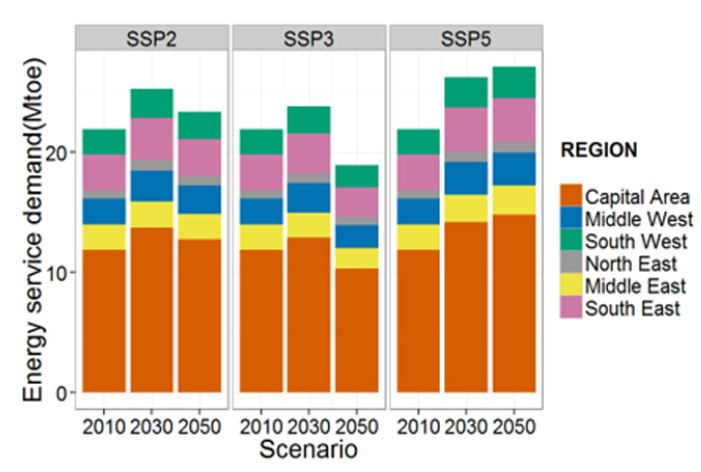
Comparison of energy service demand of each SSP scenario under climate condition of RCP8.5 by region.
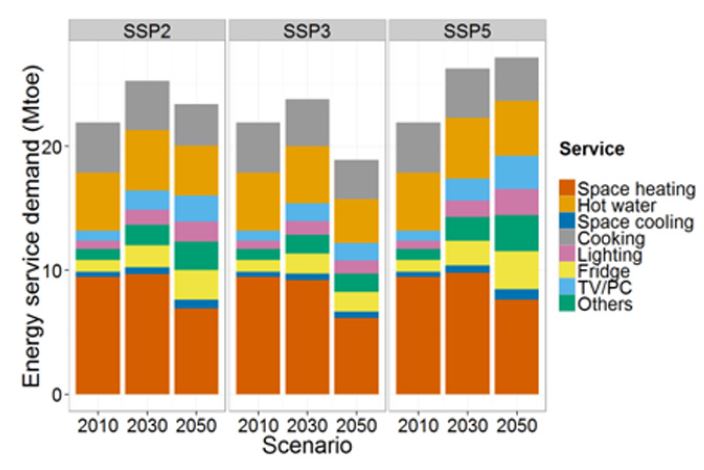
Comparison of energy service demand of each SSP scenario under climate condition of RCP8.5 by service.
The current as well as future energy use pattern is significantly dominated by space heating and hot-water use (Fig. 6). One notable trend in energy service demand is reduced heating and hot-water demand due to temperature increase (Fig. 7).
4.2 Comparisons of CO2 emission pathway
In base scenario (population and GDP of SSP2 scenario case), CO2 emission will peak, and emit 76 MtCO2 in 2030. After 2030, CO2 emission will decrease to 72 tCO2 due to population decrease. Fig. 8 (left) shows CO2 emissions in the residential sector under the different population and GDP changes. In the event of population and GDP change impacts, the emissions pattern is similar to population change in 2030, and 2050. CO2 emissions will increase by 1.13 times in SSP5, and decrease by 0.78 times in SSP3 compared to SSP2’s 2050 emission level. The gap of CO2 emissions in 2030 and 2050 is smaller than in 2020. In the case of climate change, CO2 emission will be shown fluctuation due to different potential changes by regions and climate scenario. More CO2 will be emitted in the RCP6.0 and RCP2.6 scenario due to heating and hot-water energy service demand in 2020, 2050 (Fig. 8 right). In case of Korea, climate change will help to reduce emission that comes from heating and cooling energy demand in certain period.
In the technology-frozen scenario, which represents a scenario in line with the current and the previous share of device efficiency, CO2 will be emitted 78 MtCO2. Korea residential sector can reduce 6 MtCO2 without any tax due to autonomous efficiency improvements. The carbon tax scenario at 50 US$/tCO2 to 1000 US$/tCO2 in 2050 can reduce CO2 emissions. A low discount rate, 5%, equivalent to the current interest rate of Korea, shows drastic decreases in CO2 emissions compared to a high discount rate of between 10% and 33%. In a low discount rate, no carbon tax scenario can reduce CO2 emissions more than 1000 US$/tCO2 scenario result of the high discount rate in 2050. With a long-term investment plan of customer and carbon taxes from government policy, Korea could reduce emissions by an average 16 MtCO2 compared to BaU case in 2050. To achieve the low carbon target, government should report cost-effectiveness of new device investment even if its device cost is high. And carbon taxes is needed in order to expand the use of energy-efficient devices at a faster rate than the demand side.
4.3 Co-benefits of air-pollutant reduction from CO2 mitigation measures
Fig. 10 shows the co-benefits of CO2 mitigation action in reducing energy-related air pollutant emissions. While reducing CO2 emission with mitigation measures, PM and SO2, which harm human health, can be reduced by more than the average level. There is also a benefit of large reduction potential of air pollutants, in the range of 5-40% reductions. There number is quite similar with Chae and park (2010). Regarding the reduction of emissions, energy efficiency change and fuel shift could play an important role in curbing air pollutants (see 1000 US$/tCO2 carbon tax case). In the residential sector, the use of LNG or electricity for heating services is a good way to reduce air-pollutant emission. But rural households are significantly different and characterized by the dominance of different fuels. Rural Korea is currently dependent on kerosene for heating and hot-water supply because of the lack of an infrastructure for LNG.
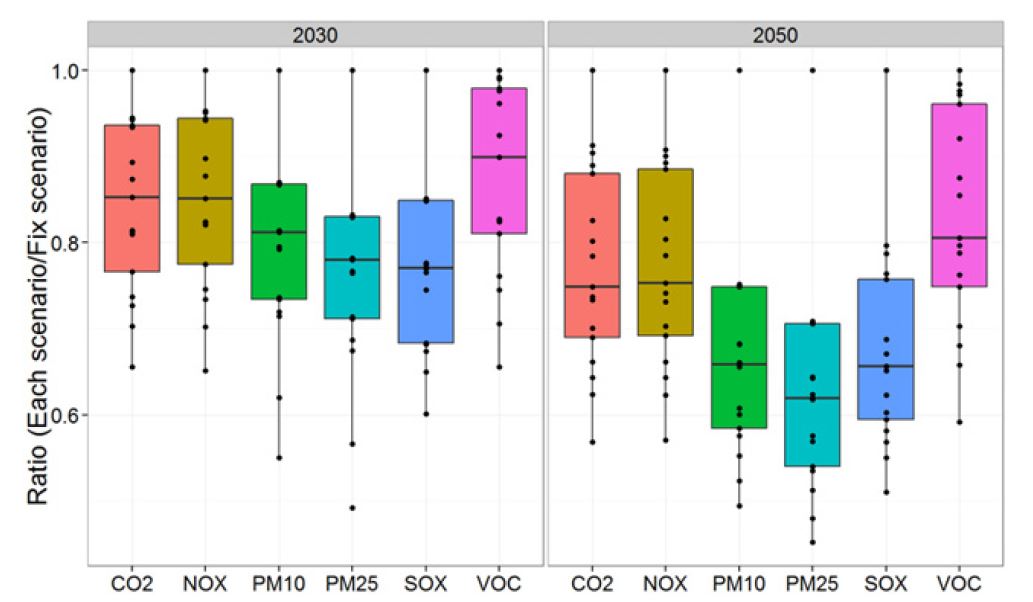
CO2 and air-pollutant emission reduction ratio with mitigation measure compared to BaU case under SSP2 and RCP85 scenario.
This study analyzed the impacts of socio-economic change, climate change and mitigation measures on CO2, and also discussed co-benefit of air-pollutant emissions reduction from climate policies such as carbon tax. Our model can present a detailed, service-based model in the Korean residential sector and power generation sector. It covered multi-gas including not only the CO2 emission but also major air pollutants such as SO2, NOx, and PM, and analyzed the co-benefits of reducing air pollutants due to CO2 mitigation actions. Socio-economic variation shows an overwhelming impact on CO2 emissions. With a long-term investment plan of customer and carbon taxes from government policy, Korea could reduce emissions by an average 16 MtCO2 compared to BaU case in 2050. There is also a benefit of large reduction potential of air pollutants, in the range of 5-40% reductions. Using energy-efficient technologies and fuel shift can play an important role in curbing air pollutants. This study has not fully considered the potential practical, political, and institutional barriers to implement each option region by region. That question will be for a future agenda to be discussed in our ongoing studies.
Acknowledgments
This work is supported by Korea Environment Industry & Technology Institute (KEITI) through Climate Change R&D Program, funded by Korea Ministry of Environment (MOE). (2018001310002) and was supported by the Environmental Research and Technology Development Fund (S-12-2) of the Ministry of the Environment of Japan
References
- Asia-Pacific Integrated Model (AIM), (2013), In: Hanaoka T. (Ed.), AIM/Enduse Model Manual, [accessed 2018 Dec 3] http://www-iam.nies.go.jp/aim/AIM_datalib/Enduse_model/Manual_EnduseModel.pdf.
-
Chae, Y, Park, J, (2011), Quantifying costs and benefits of integrated environmental strategies of air quality management and greenhouse gas reduction in the Seoul Metropolitan Area, Energy Policy, 39, p5296-5308.
[https://doi.org/10.1016/j.enpol.2011.05.034]

-
Chaturvedi, V, Eom, J, Clarke, L.E, Shukla, P.R, (2014), Long term building energy demand for India: Disaggregating end use energy services in an integrated assessment modeling framework, Energy Policy, 64, p226-242.
[https://doi.org/10.1016/j.enpol.2012.11.021]

-
Ciscar, JC, Dowling, P, (2014), Integrated assessment of climate impacts and adaptation in the energy sector, Energy Econ., 46, p531-538.
[https://doi.org/10.1016/j.eneco.2014.07.003]

-
Hanaoka, T, Akashi, O, Fujiwara, K, Motoki, Y, Hibino, G, (2014), Potential for reducing air-pollutants while achieving 2°C global temperature change limit target, Environ. Pollut., 195, p336-343.
[https://doi.org/10.1016/j.envpol.2014.06.022]

- Intergovernmental Panel on Climate Change (IPCC), (1996), Revised 1996 IPCC Guideline for National Greenhouse Gas Inventories, Cambridge University Press, Cambridge UK.
- Intergovernmental Panel on Climate Change (IPCC), (2006), IPCC Guideline for National Greenhouse Gas Inventories, Cambridge University Press, Cambridge UK, p2006.
- Intergovernmental Panel on Climate Change, (2014), Fifth Assessment Report - Climate Change 2014: Mitigation of Climate Change, http://www.ipcc.ch/report/ar5/wg3/.
- International Energy Agency (IEA), (2010a), Energy Prices and Taxes 2010.
- International Energy Agency (IEA), (2010b), World Energy Outlook 2010.
- International Energy Agency (IEA), (2010c), Energy Technology Perspective 2010.
-
Isaac, M, van Vuuren, DP, (2009), Modeling global residential sector energy demand for heating and air conditioning in the context of climate change, Energy Policy, 37(2), p507-521, http://linkinghub.elsevier.com/retrieve/pii/S0301421508005168.
[https://doi.org/10.1016/j.enpol.2008.09.051]

- Korea Energy Economics Institute (KEEI), (2002), Energy statistics of Korea.
- Korea Energy Economics Institute (KEEI), (2005), Energy statistics of Korea.
- Korea Energy Economics Institute (KEEI), (2008), Energy statistics of Korea.
- Korea Energy Economics Institute (KEEI), (2011), Energy statistics of Korea.
- Korea Power Exchange (KPE), (2001), Survey on electricity consumption characters of home appliances.
- Korea Power Exchange (KPE), (2004), Survey on electricity consumption characters of home appliances.
- Korea Power Exchange (KPE), (2006), Survey on electricity consumption characters of home appliances.
- Korea Power Exchange (KPE), (2008), Survey on electricity consumption characters of home appliances.
- Korea Power Exchange (KPE), (2011), Survey on electricity consumption characters of home appliances.
- Lee, KI, Kim, MJ, (2005), Current status for eating outside, Korea Rural Economic Institute.
- Lee, SK, (2010), Energy use in residential sector and estimation, Korea Energy Economics Institute.
- National institute of Environmental Research (NIER), (2013), National emission factors of air-pollutant, http://airemiss.nier.go.kr/.
- Yoon, SW, Lim, EH, Lee, GM, Hong, YD, (2010), Analysis of CO2 Emission Pattern by Use in Residential Sector, Climate Change Research, 1(3), p189-203.
- U.S. Environmental Protection Agency, (1995), Emissions Factors & AP 42 Compilation of Air Pollutant Emission Factors, http://www.epa.gov/ttnchie1/ap42/.
-
Van Vuuren, DP, Riahi, K, Moss, R, Edmonds, J, Thomson, A, Nakicenovic, N, Kram, T, Berkhout, F, Swart, R, Janetos, A, Rose, SK, Arnell, N, (2012), A proposal for a new scenario framework to support research and assessment in different climate research communities, Glob. Environ. Chang., 22, p21-35.
[https://doi.org/10.1016/j.gloenvcha.2011.08.002]

-
Yu, S, Eom, J, Zhou, Y, Evans, M, Clarke, L, (2014), Scenarios of building energy demand for China with a detailed regional representation, Energy, 67, p284-297.
[https://doi.org/10.1016/j.energy.2013.12.072]

-
Zhou, N, Fridley, D, Khanna, NZ, Ke, J, McNeil, M, Levine, M, (2013), China’s energy and emissions outlook to 2050: Perspectives from bottom-up energy end-use model, Energy Policy, 53, p51-62.
[https://doi.org/10.1016/j.enpol.2012.09.065]


